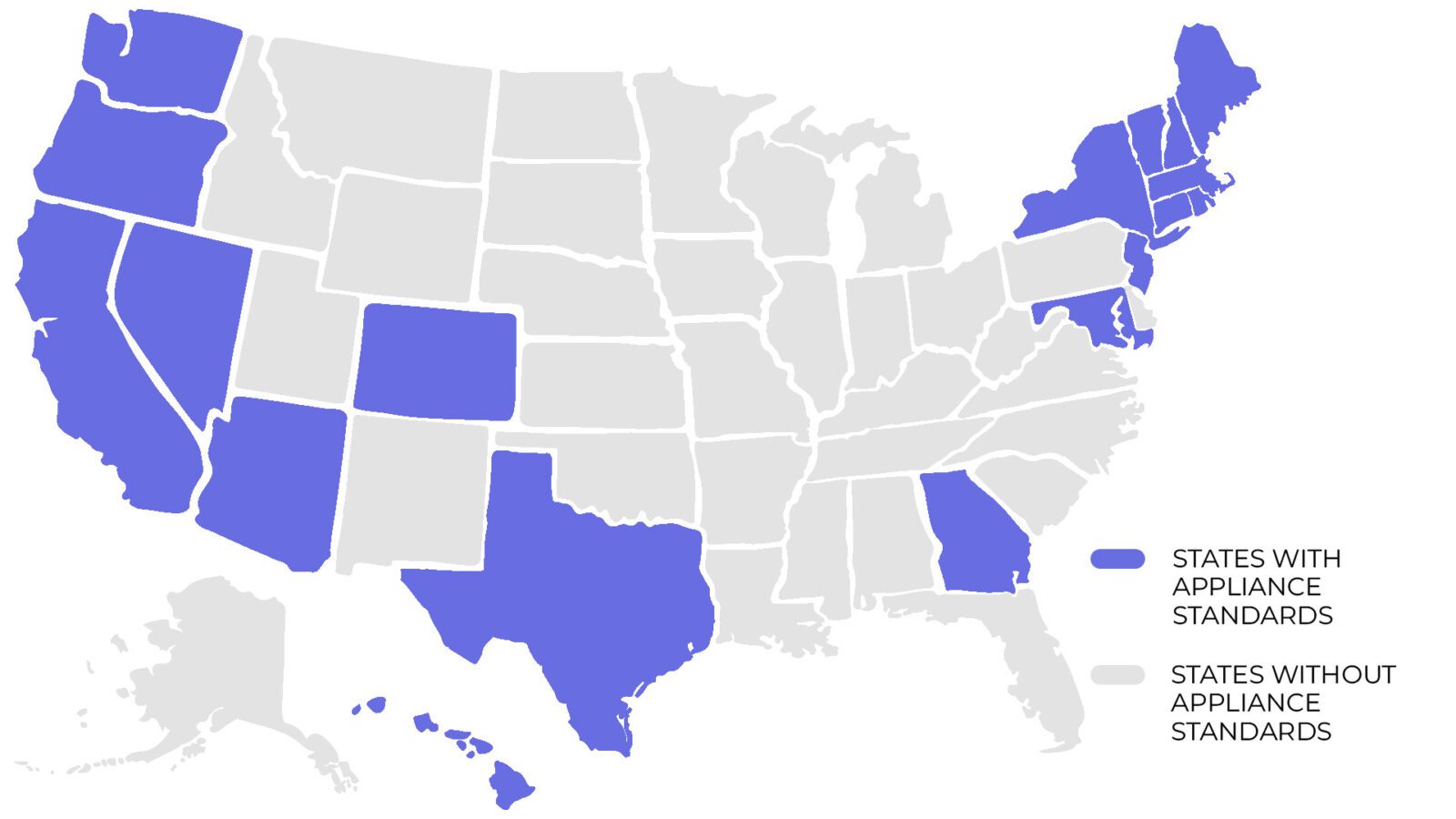Climate XChange’s Dashboard Digest is a deep dive on each of the policies that we track in the State Climate Policy Dashboard and an exploration of how these policies can interact with one another to form a robust policy landscape. The series is intended to serve as a resource to state policy actors who are seeking to increase their understanding of climate policies, learn from experts in each policy area, and view examples of states that have passed model policies.
There are a wide range of policy approaches for tackling the climate crisis. Some solutions have the potential to reduce large amounts of greenhouse gas emissions, but they require large capital investments and benefits will not be seen immediately. Appliance efficiency standards, on the other hand, can immediately reduce emissions from homes and businesses, all while providing savings on utility bills for the consumer and reducing energy demands on the power grid.
Appliance standards establish the minimum level of efficiency required for specific products sold at the state or federal level, eliminating the need for consumers to choose between safer, more efficient appliances, and cheaper, less efficient alternatives. Appliance standards encourage more efficient product innovation, and even if products become more expensive, the total energy savings outweigh any additional costs.
For this article, Climate XChange spoke with Brian Fadie from the Appliance Standards Awareness Project (ASAP) about how this climate policy has been quietly reducing emissions while saving large amounts of energy and money for consumers.
Learn more about other Buildings & Efficiency policies on our Dashboard Resource Hub.
READ MORE >
What are Appliance Standards?
Appliance standards set the minimum energy and/or water efficiency requirements for the sale of specific products. There are appliance standards for dozens of different products, targeting both residential appliances (e.g. toilets, televisions, and showerheads) and commercial ones (e.g. dishwashers, ovens, and lighting). The standards themselves target different performance metrics like the amount of energy used when an appliance is in standby mode, the maximum rate that water comes out of a faucet or showerhead, or how much cooling power is required per watt-hour of electricity.
Manufacturers may produce more efficient appliances than the minimum, but appliance standards remove the option for consumers to purchase inefficient alternatives. Appliance standards are set at both the state and federal levels — state standards apply to products sold within a state, while federal standards apply to products manufactured in the U.S. or imported into the country. National appliance standards cover about 90 percent of home energy use, 60 percent of commercial building energy use, and 30 percent of industrial energy use.
Typically, appliance standards are first set at the state level; historically California has led the effort. Then other states may choose to adopt the same or similar standards, or instead can write their own. When a number of states have adopted appliance standards for a particular product, manufacturers, states, and energy advocates will often negotiate for consensus agreements for national appliance standards recommendations, preferring one uniform policy rather than a patchwork of different state requirements.
State appliance standards are most often passed by legislatures, with each bill naming the specific appliances covered by the standard. The bill text itself may contain the actual standard, or may direct a state agency to develop the appliance standard for each product. In some states, energy agencies have the authority to develop and adopt appliance standards on their own. This can reduce administrative procedures for appliance standards and happens in both New York and California, two states with some of the strongest policies.
The Department of Energy (DOE) is responsible for developing and enforcing national appliance standards, but they must be granted authority from Congress. After a federal appliance standard is adopted, states are usually unable to adopt their own. There are some exceptions to this rule: DOE does give states the ability to adopt their own, more stringent standards for some products including faucets, showerheads, toilets and urinals.
Current State of Appliance Standards

Benefits of Appliance Standards
Lower Energy Bills
Appliance standards help lower overall home energy and water use by making appliances more efficient, which saves ratepayers money on their bills. According to ASAP, the average consumer is already saving $500 per year on their utility bills because of national appliance standards. As newly adopted national standards take effect, the Biden administration expects that number to increase, saving consumers $570 billion cumulatively over 30 years.
Fadie says that a major trend in appliance standards today revolves around showerheads and faucets. “If you run the numbers on each of the products, how much energy can be saved, showerheads and faucets are the biggest energy savers.” Appliance standards for these products help by reducing water use, which is crucial for drier regions, while also conserving energy that is used to heat the water.
According to the EPA, by switching to a more efficient showerhead, the average family could save 2,700 gallons of water and more than 330 kilowatt hours of electricity per year. That’s enough electricity to power the average American home for 11 days. If every home in the country were to install energy efficient showerheads, we’d save more than $2.9 billion and more than 260 billion gallons of water annually.
Appliance standards also target a hard-to-reach category for building-sector policies: renters. Tenants usually pay utility bills, but don’t typically pay for residential upgrades, meaning many apartment buildings aren’t updated with energy efficiency in mind, both structurally and appliances. Appliance standards raise minimum levels of energy efficiency, so when a new appliance is purchased it’s more likely to save money for ratepayers, whether it was purchased by a landlord or tenant. This helps to address the split-incentive challenge as well as protect consumers in “panic-purchase” situations where an appliance needs to be immediately replaced. Fadie says this makes the choice easy for consumers. “If you’re in a state with standards, and you go to the store to buy a product, you don’t have to do a research project to know what’s the more energy efficient version.”
Reduce Emissions
As appliance standards ensure that products use less energy, they also help avoid emissions from dirty sources of energy, particularly fossil-fueled power plants. Actual emissions savings vary widely depending on each state’s electricity portfolio, climate, and energy-use data. Fadie says that appliance standards would reduce emissions in every state, and ASAP can help state actors by quantifying those benefits. Their models assume that each state adopts all recommended appliance standards and lists the energy and emissions savings for both the near- and long-term. For example, Florida would reduce CO2 emissions by 927 thousand metric tons annually by 2040 if they adopted all recommended standards according to ASAP. This is roughly equivalent to taking 200,000 gas-powered passenger vehicles off the road each year.
According to the EPA, a typical passenger vehicle emits about 4.6 metric tons of CO2 each year.
READ MORE >
Increase Grid Reliability
Adopting appliance standards can help protect the power grid as a whole by reducing peak electricity demand. Many products, like air conditioners and dishwashers, are often used during periods of peak demand which can strain energy resources. Efficient appliances use less energy and can help prevent large spikes in power demand. This can help grids transition away from existing fossil-fuel power plants as well as reduce the need for additional generation infrastructure. Updated national appliance standards could result in up to a 13 percent reduction in total peak demand by 2050, according to a report from ACEEE.
Improve Public Health
Reducing energy bills can also help improve public health, particularly in low-income households which typically spend a higher portion of their income on energy when compared to non-low income households. This energy insecurity can result in families being forced to forgo heating or cooling their homes in order to afford other necessities like food and healthcare.
Because appliance standards raise the minimum efficiency requirements for products, they can reduce energy bills and lighten the burden for low-income households. Maintaining safe indoor temperatures is becoming increasingly important as cities and states are more frequently experiencing dangerous heat waves in the summer or unpredictable cold weather events in the winter.
Barriers to Appliance Standards
Opposition to Regulation
Some industries may oppose appliance standards because they’d rather not be regulated, Fadie told Climate XChange. Our expert says it’s not every industry, but some manufacturers may see increased costs as a result of the regulations. To alleviate this concern, appliance standards programs usually have a lag time in between when they are passed and when they go into effect, so that manufacturers have time to prepare for the change.
Additionally, the Department of Energy is trying to bust the myth that appliance standards will increase costs to consumers while decreasing product quality. Appliance standards often undergo public rulemaking procedures, which can elevate the voices of various stakeholders to ensure that appliances use less energy, last longer, and save consumers money.
Lack of Awareness
Another potential barrier for appliance standards is a side-effect of their benefits: they work quietly in the background and consumers may not necessarily know that product innovation can be attributed to this policy. In fact, Fadie calls appliance standards “the best energy and climate policy you’ve never heard of.” He also says that while just 18 states have currently adopted appliance standards, ASAP is expecting others to adopt them soon. The states to look for are those that have recently passed major climate laws, but don’t yet have any appliance standards. States like Minnesota, Michigan, and Illinois recently published Climate Action Plans, all of which emphasize energy efficiency and appliance standards can help them reach their climate goals.
What Can States Do?
Pass Appliance Standards
Appliance standards are typically passed in a few states first, with others adopting the same or similar standards later on, with the ultimate goal of a national standard down the road. This process can be really beneficial for states that have climate goals, but may not have sufficient resources to invest in researching and developing appliance standards. Smaller states can take advantage of the heavy lifting already done by states that have existing appliance standards, and then adopt the same one with confidence that it can help them meet climate goals and save money.
Fadie says that advocates, legislators, and other state-level actors can reach out to ASAP for assistance with appliance standards. They can provide energy and cost savings data, technical assistance, model bills, and other resources to help draft legislation.
Voice Support for National Appliance Standards
State appliance standards can be effective tools to help reduce emissions and save money, however a national efficiency standard is far more effective than a patchwork of state laws. National appliance standards are generally more favored by manufacturers, can maximize emission reductions, and protect consumers from inefficient appliances. State actors can participate in Department of Energy rulemaking procedures by providing comments and participating in public meetings or webinars.







